
on saturday, 4 november 2017, readers of mas context will have the chance to get a behind-the-scenes look at selected items from the ryerson & burnham archives located at the art institute of chicago.
five chicago-based architects/offices will select items of the collection and discuss them in relationship to their practice, the discipline, and/or society. nathaniel parks, art and architecture archivist of the ryerson & burnham libraries, will share the history of the same items.
participants include:
stewart hicks and alison newmeyer – design with company
sean lally – sean lally
ann lui and craig reschke – future firm
margaret mccurry – tigerman mccurry
alison von glinow and lap chi kwong – kwong von glinow design
the ryerson & burnham archives’ collections are notably strong in late nineteenth- and twentieth-century american architecture, with particular depth in midwestern architecture. architects such as edward bennett, daniel burnham, bruce goff, bertrand goldberg, ludwig hilberseimer, mies van der rohe, louis sullivan, and frank lloyd wright are represented in a broad range of papers. major architectural events, such as the world’s columbian exposition of 1893 in chicago, the century of progress international exposition of 1933–1934 in chicago, and the world’s fair of 1939 in new york, are also represented in an individual archive.
the event is free with museum admission. please, check coats and bags before entering the library.

This week there’s serendipity in the air in Chicago and Paris. That’s because this week we received a shout from [ Maison & Objet ] [ Chicago Architecture biennial ] and we were sent Lessons from the Eiffel Tower (below). It’s because we’re reminded the M&O event occurs in Paris in January 2016. The Biennial reminds us weekly through 3 January 2016. Architect Daniel Burnham reminds us of big plans as does engineer Alexandre Gustave Eiffel.
Make no little plans; they have no magic to stir men’s blood and probably themselves will not be realized. Make big plans; aim high in hope and work, remembering that a noble, logical diagram once recorded will never die, but long after we are gone be a living thing, asserting itself with ever-growing insistency. Remember that our sons and our grandsons are going to do things that would stagger us. Let your watchword be order and your beacon beauty.
~ daniel burnham, architect
Lessons from the Eiffel Tower
> It was designed at home, on the kitchen table by someone who didn’t get their name on it
> Never been done before, not guaranteed to get built or to work
> It was criticized by hundreds of leading intellectuals and cultural experts
> It wasn’t supposed to last very long
> It’s designed to be an icon, it’s not an accident
> People flock to it because it’s famous
> You can sketch a recognizable version of it on a napkin
above > built in 1887 and opened in ’89, the eiffel tower is an iron lattice tower. it was named after the engineer alexandre gustave eiffel, whose company designed and built the tower | click on image to activate lightbox – six images [ eiffel tower history ] [ 10 things you may not know about the eiffel tower ][ seth godin ]

above> image from the 1909 publication ”Plan of Chicago” by Daniel Burnham. Burnham was famous for the dictum “Make no little plans,” and Jules Guerin’s alluring watercolor renderings in the published “Plan of Chicago” gave this vision an ethereal cast. [ 100 years. Daniel Burnham’s Chicago Plan ]

Chicago architecture critic, Blair Kamin reports that the Zaha Hadid pavillion is not up and running yet and a new contractor has been hired. There is an August 1 deadline to complete fabrication or delay penalties kick in. What may come out of this is simply the initial contractor was not up to the task. Or the architect’s concept is just that.
See feature article for more details on the Burnham Plan Centennial events.

Chicago’s Burnham plan is 100 years old.
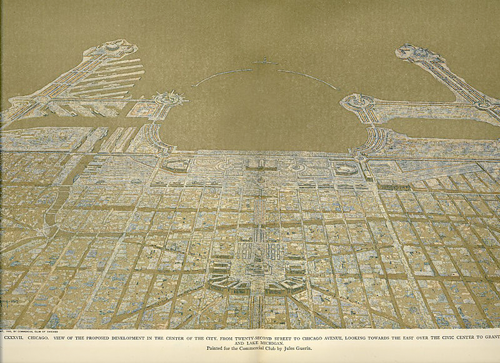
above: image from the 1909 publication ”Plan of Chicago” by Daniel Burnham. Burnham was famous for the dictum “Make no little plans,” and Jules Guerin’s alluring watercolor renderings in the published “Plan of Chicago” gave this vision an ethereal cast.

above: daniel hudson burnham.
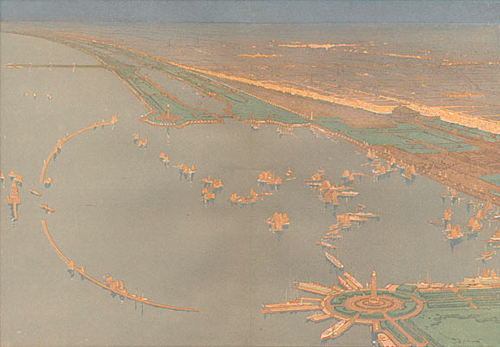
above: This view from the Plan of Chicago shows Grant Park and a proposed harbor in the lake. Much of Daniel Burnham’s plan for the layout of the city was implemented. In addition to being an important planning document, the 1909 plan was a beautiful work of art. (Photo courtesy Chicago Historical Society)
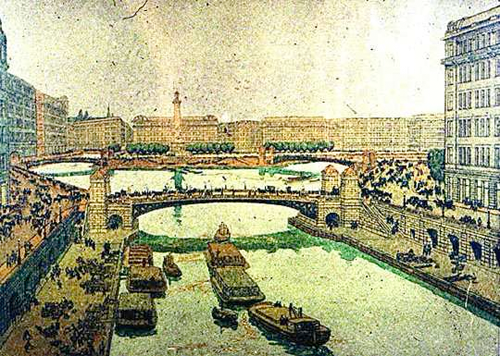
above: River intersection, from Daniel H. Burnham and Edward H. Bennett, Plan of Chicago. note: the building depicted on the far right is now merchandise mart which was built in 1930.
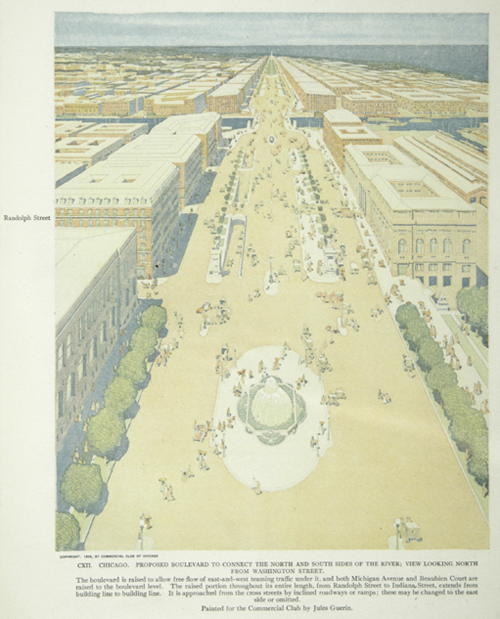
above: Guerin, Jules. “Proposed Boulevard to connect the north and south sides of the river; View looking north from Washington Street.” (artwork courtesy of Newberry Library) note: in 1909 no one appears to have envisioned the “sky scraper” though “invented” by William Le Baron Jenney (1832–1907) with his ten-story Home Insurance Building on the corner of La Salle and Monroe streets in Chicago in 1885.
2009
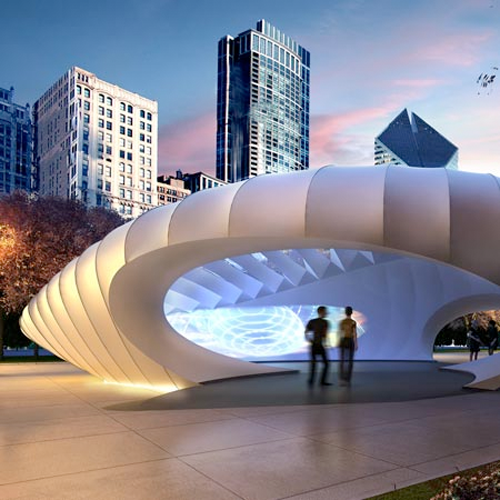
above: Burnham Pavilion by Zaha Hadid Architects, a temporary pavilion in Millennium Park, Chicago.
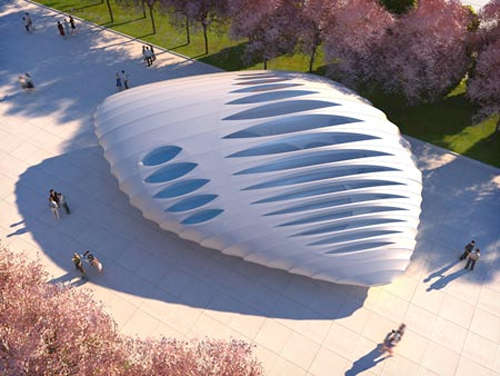
above: The pavilion, along with another designed by UNStudio (see below), will celebrate the Burnham Plan Centennial events and will be open to the public from 19 June to 31 October.
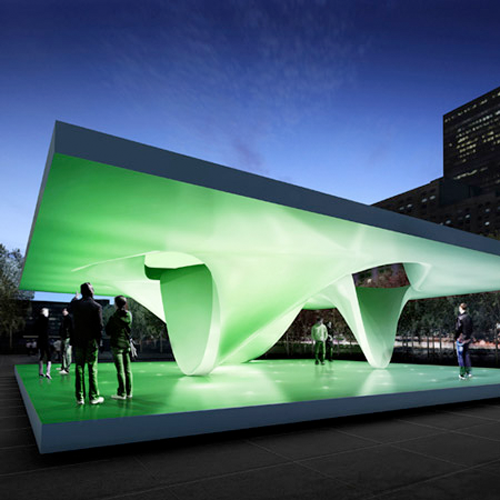
above: The temporary pavilion from Ben van Berkel of UNStudio.
Scale model
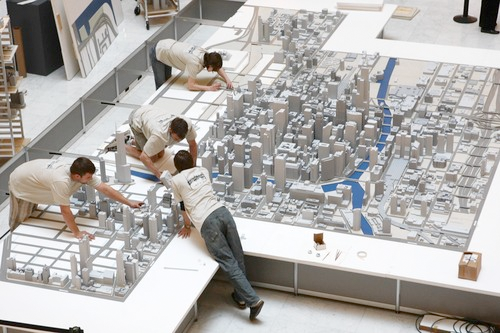
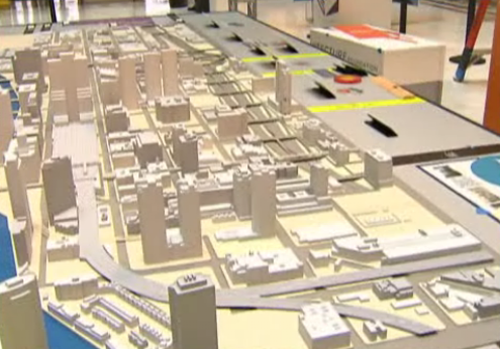
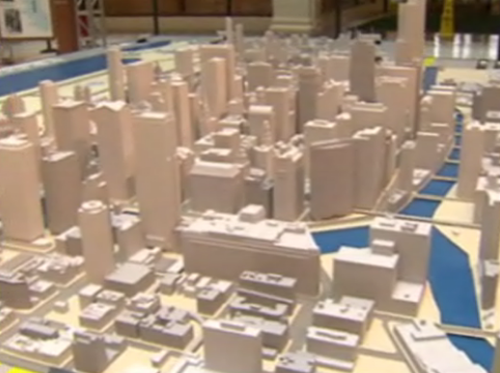
above: The Chicago Architecture Foundation putting together a scale model of Chicago at its headquarters on Michigan Avenue in celebration of the centennial of the Burnham Plan.
WGN: video of scale model
Chicago was lucky to have an urban visionary who not only had credibility but social clout amongst Chicago’s elite. Planning for this Centennial has been going on for over a year and there are fortunately
many resources.
The future
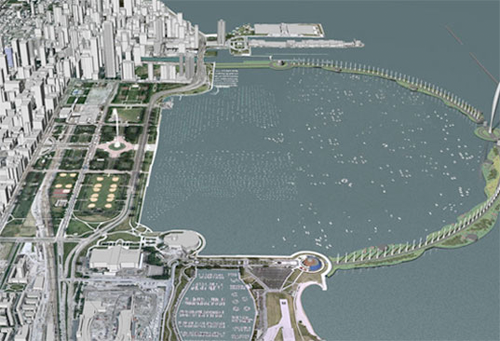
above: proposed Eco-Bridge will serve as a breakwater in the Monroe Harbor and create recreational space for residents and visitors.
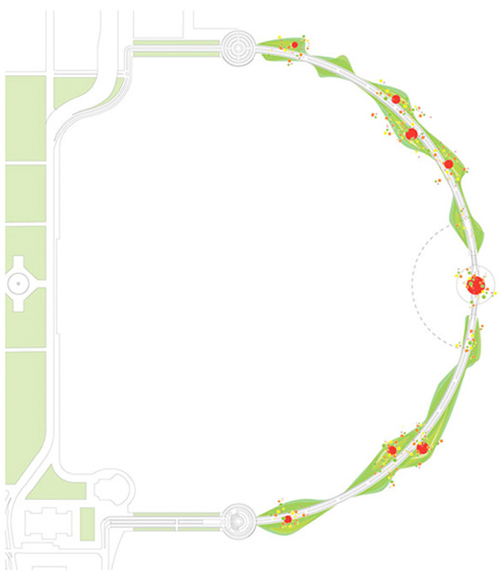
above: to give a modern and sustainable twist to the original idea, wind turbines will also be incorporated in the project to add economic value and show Chicago’s dedication to sustainability. An observation tower will be placed at the center of the bridge, providing spectacular views of the lake and city.
Chicago hopes that the Eco-Bridge will further enhance their bid for the 2016 Olympic Games – they hope the observation tower will be used to house the Olympic flame.
Chicago is also lucky to have a visionary with all kinds of clout who is inspired by Europe, loves all things green, bikes all over the city, likes scale models and the Olympic Games. Thank you mayor Richard M. Daley.
Additional information:
The Burnham Plan: the plan for chicago
Chicago Architecture Foundation: burnham plan centennial events
The Art Institute of Chicago: without bonds or limits
Wikipedia: daniel burnham
Wikipedia: burnham plan
The Urbanophile: what made the plan successful
Inhabitat: eco-bridge
Paul Goldberger: toddlin’ town
Unbeige: excited mayor leads to scale model




















